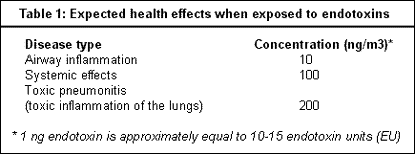Endotoxins: a new concern for workers in the wastewater industry

In the past, many respiratory health effects related to workers in the wastewater field may have been incorrectly diagnosed and may be directly related to exposure to large doses of endotoxins, which are produced by bacteria—specifically gram-negative bacteria—during cell growth, division or death.
By Timothy R. Horn, industrial hygienist, ECS Risk Control
Table of Contents
Why the concern over endotoxins?
Sampling and analysis procedures
What can be done to control workers' exposure to endotoxins?
A portion of the outer wall of a gram-negative bacteria cell, endotoxins have been associated with many respiratory symptoms and complaints related to specific occupational environments. In particular, the wastewater industry routinely deals with bacteria and, as a result, endotoxins during the treatment of human waste and its by-products on a daily basis. The bacteria associated with those processes are often that which the human body is trying to rid itself of. Studies have indicated that daily exposure to these bacteria may not be healthy.
Why the concern over endotoxins?
Exposure to endotoxins has been linked to fever, cough, shortness of breath, headache, nose and throat irritation, nausea, chest tightness, acute airway flow restriction and inflammation. Response to endotoxins varies with dose, site, route and rapidity of release into the blood system. Response also may be affected by the general overall health of the individual. Even low doses can cause changes in body temperature, metabolism, and in the hematological (blood making), immune and endocrine systems of the body.
Gram-negative bacteria are naturally occurring and found in a number of environments. They are associated with plants and animals, and found in the oral cavities and intestinal tracts of many different mammals. They are also plentiful in water. Studies indicate they also have been found to populate ventilation systems and humidification devices. The type of gram-negative bacteria that contain endotoxins include but are not limited to E. Coli, Salmonella, Pseudomonas, and Haemophilis. Endotoxins have been detected in the air, dust and water, however typical exposures occur through the air. Endotoxin exposure is highest when the water containing the endotoxin is aerosolized. Significant exposure locations include sludge pressrooms or aeration tanks at wastewater treatment facilities. The processes in these areas tend to aerosolize water and create droplets that can be inhaled by workers. (Return to Table of Contents)
Sampling and analysis procedures
Air sampling for endotoxins consists of a sampling device equipped with an endotoxin-free, glass-fiber filter cassette. The sample is collected in the breathing zone (eight to 10 inches from the nose and mouth) of the employee or in the area of the suspected exposure. At the conclusion of sample collection, the sampling cassette containing the filter is sent to a lab for analysis by Limulis amebocyte lysate (LAL) kinetic chromogenic method. Sampling for endotoxins also may include placement of sampling water and dust into endotoxin-free containers.
No enforceable standards have been established to date by the Occupational Safety and Health Administration (OSHA), the National Institute of Occupational Safety and Health (NIOSH) or the American Conference of Governmental Industrial Hygienists (ACGIH). These organizations typically establish acceptable levels of exposure to occupational contaminants. Therefore, worker exposure results have to be compared to guidelines based on challenge studies and field studies. One study conducted by a leading authority on endotoxins, Dr. Ragnar Rylander, establishes a no effect level 94 less than 10 ng/m3. The following table indicates the expected health effects when exposed to the listed concentration.

Recent studies conducted by ECS Risk Control at wastewater facilities found endotoxin concentrations as high as 290 ng/m3. Several of the employees at the facilities had complained of respiratory distress on the job and after they left the workplace. Possible exposure is not limited to the wastewater industry; exposure also has been associated with agricultural and industrial waste processing settings. (Return to Table of Contents)
What can be done to control workers' exposure to endotoxins?
Control of endotoxins in wastewater facilities can be difficult since they are naturally occurring in water and even more prevalent in wastewater. Uncontrolled flow of wastewater in areas populated by workers should be minimized and releases cleaned up quickly. Ventilation in these areas should be properly functioning to draw aerosolized water away from the breathing zone of the employee. HEPA filtration systems can be used to collect the airborne droplets. Wearing a respirator equipped with a dust, mist and fume cartridge in these areas can also offer protection to the employee.
About the author: Tim Horn is a senior industrial hygienist for ECS Risk Control. ECS, an XL Capital Company, is an underwriting manager providing integrated environmental risk management solutions worldwide, and is headquartered in Exton, Pennsylvania. For more information, contact the company at 520 Eagle View Boulevard, Exton, PA 19341; phone 610-458-7280.
Edited by Tracy Fabre
Managing Editor, Water Online
